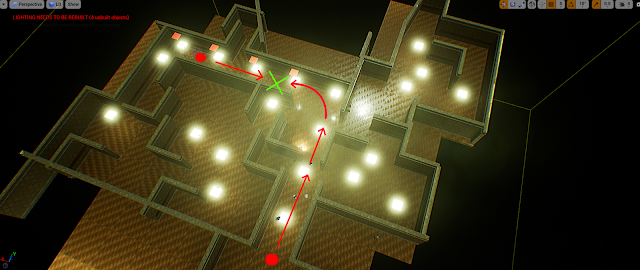The Confession of Pain: The Camera Behind The Video
The Camera Behind The Confession of Pain
Lighting played a big part in the piece. It had to be coordinated with the animation and the movement of the camera. When thinking about color, I chose red. It is the first thing that comes to my mind when thinking about pain and probably to many others. It worked well with the color of the walls (the green and yellow wallpaper), which again had a symbolic meaning, the color- green representing ill health. In my concept, the room in which the elderly woman stood had to become progressively overfilled with the color red, together with her increased limping and distorted body movement. It was to visualise the chronic pain which spreads and sometimes leads the way of life. Just like it, the model is going in the direction of the red light, which leads her further into the labyrinth. Camera movement and angles became very important to me. I wanted the audience to be immersed in what has become a quite cinematographic experience. In the meantime of creating the video, I got inspired by the way Stanley Kubrick directed his scenes. He is known for using the one-point perspective shot in which the whole focus of the scene leads to a specific point:
 |
| A Shot from a Movie Shining by Stanley Kubrick |
The first meeting point of the audience and the character was a crucial moment. At the first the elderly woman appeared as a blurred figure, quite a distance away from the viewer. As the video progresses the camera moves closer to the woman. When her face is finally visible, the red light comes on.
 |
| Before Taking the Turn |
 |
| Facing the Character |
 |
| The Appearance of the Woman |
As the red light intensifies, the camera moves away from the woman, shortly cutting to a different shot. In the new scene, two legs of the character become the focal point. This important shot becomes the moment the movement of the woman is revealed to the audience. As the camera follows the character, her limping becomes more apparent, progressively becoming more distorted and exaggerated.
This is the scene in which the camera starts following the character. The woman is not a threat anymore - the viewer is taken along on her difficult journey. The different angles of the camera allow the audience to see various sides of the character and her movement before finally facing her again. In the last shots of the film. the camera stalks the approaching woman from a distance. As she takes the exact turn that the viewer has taken at the beginning of the film, the camera creeps on the character liting her and the room in bright white light, dimming the red.










Comments
Post a Comment